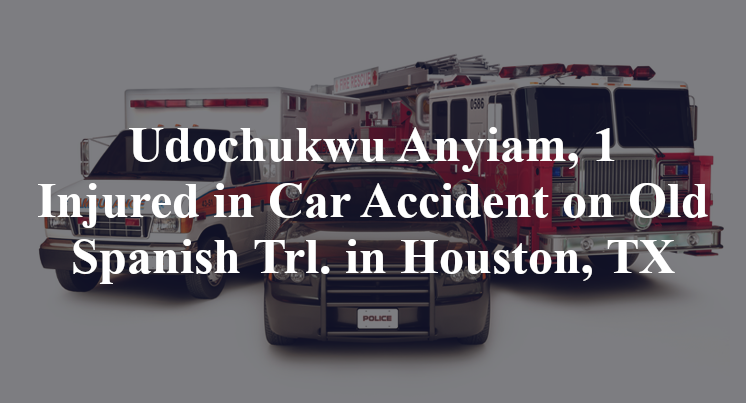Udochukwu Anyiam, 1 Injured in Car Accident on Old Spanish Trl. in Houston, TX
Harris County, TX — July 289, 2024, Udochuckwu Anyiam and one other person were injured due to a car accident at approximately 2:30 p.m. along Old Spanish Trail.
According to authorities, 22-year-old Udochuckwu Anyiam was traveling in an eastbound Toyota Camry on Old Spanish Trail near the Sutherland Street intersection when the accident took place.

Officials indicate that, for as yet unknown reasons, a westbound Honda CR-V occupied by a 58-year-old woman and an 18-year-old woman drove on the wrong side of the road. A head-on collision consequently occurred between the Honda and the Toyota.
Anyiam and the woman who had been behind the wheel of the Honda reportedly sustained serious injuries over the course of the accident. They were each transported to local medical facilities by EMS in order to receive necessary treatment. Additional details pertaining to this incident are not available at this point in time.
Commentary
When a crash involves a vehicle traveling the wrong way, the natural instinct is to assume human error. But serious injuries and unusual circumstances demand more than quick conclusions—they call for a closer look at what really caused the situation to unfold the way it did.
1. Did the authorities thoroughly investigate the crash?
A head-on collision with one vehicle reportedly on the wrong side of the road raises immediate concerns about how and why that path was taken. Did investigators confirm whether the Honda crossed over intentionally, by mistake, or due to loss of control? Were tire marks, impact angles, or scene evidence reviewed to verify the vehicle’s movements before the crash? Without a detailed reconstruction of events, it’s hard to know whether this was a simple case of wrong-way driving or something more complex that required further attention.
2. Has anyone looked into the possibility that a vehicle defect caused the crash?
If the Honda CR-V suddenly veered into oncoming traffic, a mechanical or electronic failure can’t be ruled out. A steering issue, brake malfunction, or even unintended acceleration could easily explain how the vehicle ended up on the wrong side. Similarly, it’s worth asking whether either vehicle had any issues that might have reduced the chance of avoiding the collision—such as malfunctioning driver assistance systems or stability controls. These factors are often missed unless someone inspects the vehicles after the fact, which doesn't always happen.
3. Has all the electronic data relating to the crash been collected?
Both vehicles likely carried systems that recorded what happened just before the crash—steering input, braking behavior, speed, and safety alerts. That data can help confirm whether the Honda drifted or swerved, whether the Camry attempted to avoid the crash, and how quickly things escalated. On top of that, footage from street cameras or nearby businesses may exist and could show how the incident began. But unless someone made an effort to recover those records early on, they may now be lost.
When people are seriously hurt and the cause isn't clear, the worst outcome is settling for half-answers. Getting to the truth takes more than assigning blame—it takes work, curiosity, and follow-through.
Takeaways:
- Wrong-way crashes require precise scene analysis to confirm how the path deviation occurred.
- Vehicle malfunctions—especially in steering or braking—can explain sudden lane crossings.
- Data from onboard systems and nearby cameras often fills in critical pre-crash moments.

*We appreciate your feedback and welcome anyone to comment on our blog entries, however all visitor blog comments must be approved by the site moderator prior to showing live on the site. By submitting a blog comment you acknowledge that your post may appear live on the site for any visitors to see, pending moderator approval. The operators of this site are not responsible for the accuracy or content of the comments made by site visitors. By submitting a comment, blog post, or email to this site you acknowledge that you may receive a response with regard to your questions or concerns. If you contact Grossman Law Offices using this online form, your message will not create an attorney-client relationship and will not necessarily be treated as privileged or confidential! You should not send sensitive or confidential information via the Internet. Since the Internet is not necessarily a secure environment, it is not possible to ensure that your message sent via the Internet might be kept secure and confidential. When you fill out a contact or comment form, send us an email directly, initiate a chat session or call us, you acknowledge we may use your contact information to communicate with you in the future for marketing purposes, but such marketing will always be done in an ethical way.